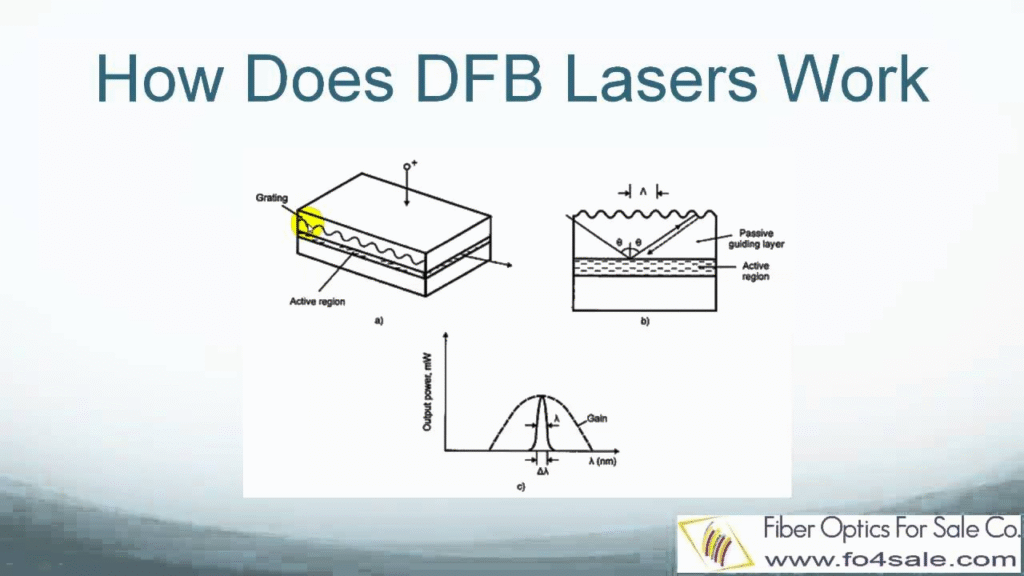In the field of photonics and optical communication, precision, stability, and efficiency are crucial for applications ranging from telecommunications to sensing technologies. One technology that has become increasingly significant is DFB lasers (Distributed Feedback Lasers). Known for their narrow linewidth, high spectral purity, and reliable single-mode operation, DFB lasers have become the backbone of many modern optical systems.
This article explores the technology, working principles, applications, and benefits of DFB lasers, highlighting why they are vital in the advancement of optical communication, spectroscopy, and sensing.
What Are DFB Lasers?

DFB lasers, or Distributed Feedback Lasers, are a type of semiconductor laser designed to emit light in a single longitudinal mode. Unlike conventional Fabry-Pérot lasers, which may emit multiple wavelengths simultaneously, DFB lasers incorporate a built-in diffraction grating along the laser cavity. This grating provides feedback at a specific wavelength, ensuring highly stable and single-mode operation.
Key Characteristics of DFB Lasers
- Single-Mode Operation: Eliminates mode competition, providing a pure spectral output.
- Narrow Linewidth: Ensures minimal spectral broadening, critical for high-speed communications.
- High Stability: Temperature and current-tuned designs allow precise wavelength control.
- Low Phase Noise: Ideal for coherent optical systems and sensitive detection applications.
These characteristics make DFB lasers highly desirable in telecommunications, spectroscopy, and sensing systems.
How DFB Lasers Work
The working principle of DFB lasers relies on the combination of semiconductor gain media and distributed feedback mechanisms:
- Semiconductor Gain Medium: Provides amplification of light through stimulated emission.
- Diffraction Grating: Embedded along the laser cavity, it selectively reinforces a single wavelength and suppresses others.
- Optical Feedback: The grating ensures that light at the desired wavelength resonates within the cavity, producing stable and coherent emission.
- Temperature and Current Tuning: Adjusting the laser’s temperature or injection current fine-tunes the emission wavelength, allowing precise control.
This design results in a laser with a highly stable, narrowband output that is resistant to mode hopping, making DFB lasers ideal for critical optical applications.
Applications of DFB Lasers
DFB lasers are widely used across industries due to their precision, stability, and spectral purity. Here are some key applications:
1. Telecommunications
- Fiber-Optic Communication: DFB lasers serve as the primary light source for long-haul and metro optical networks, supporting high-speed data transmission.
- Dense Wavelength Division Multiplexing (DWDM): Their narrow linewidth allows multiple signals to coexist on the same fiber without interference.
- Coherent Communication Systems: Low phase noise and high stability enhance coherent detection performance, improving bandwidth and signal integrity.
2. Sensing and Measurement
- Gas Sensing: DFB lasers can detect trace gases by tuning to specific absorption lines, used in environmental monitoring and industrial safety.
- Temperature and Strain Sensing: In fiber optic sensor systems, DFB lasers provide stable light sources for interferometric or fiber Bragg grating sensors.
- Spectroscopy: High spectral purity enables precise measurement of molecular absorption features in laboratory and industrial spectroscopy.
3. Medical and Biotechnology
- Biomedical Imaging: DFB lasers are used in optical coherence tomography (OCT) systems for high-resolution imaging of tissues.
- Diagnostic Devices: Their stable output allows accurate spectroscopic analysis of biological samples.
4. Industrial and Military Applications
- Laser Radar (LIDAR): High coherence and narrow linewidth enhance range resolution and detection accuracy.
- Precision Manufacturing: DFB lasers are used in metrology and material processing where accuracy is critical.
- Defense Applications: Their reliability and stability make them suitable for secure optical communication and sensing systems.
Advantages of DFB Lasers
DFB lasers offer several advantages over traditional semiconductor and Fabry-Pérot lasers:
- High Spectral Purity: Single-mode operation ensures minimal spectral noise and interference.
- Wavelength Stability: Resistant to temperature variations and mode hopping.
- Low Threshold Current: Efficient operation reduces power consumption.
- Compact Design: Integrated grating reduces the need for external wavelength-selective components.
- Scalability: Suitable for integration into dense optical networks and multi-channel systems.
These benefits make DFB lasers a preferred choice for high-performance optical systems requiring precision, reliability, and efficiency.
Factors to Consider When Choosing DFB Lasers
Selecting the right DFB laser involves evaluating several technical and operational parameters:
1. Wavelength Requirements
- Match the laser wavelength with the target application, whether for telecommunications (e.g., 1310 nm, 1550 nm) or gas sensing (specific absorption lines).
2. Linewidth
- Narrow linewidth is essential for coherent systems, DWDM, and high-resolution spectroscopy.
3. Output Power
- Consider the required power for the application, ensuring sufficient signal strength while avoiding thermal issues.
4. Temperature and Current Tuning Range
- Determine if fine-tuning of wavelength is necessary for sensing or communication applications.
5. Reliability and Lifetime
- Evaluate manufacturer specifications for mean time to failure (MTTF) and operational lifetime, particularly for critical or long-term installations.
6. Packaging and Integration
- Consider how the DFB laser will be integrated into existing systems, including fiber coupling, mounting, and thermal management.
By carefully considering these factors, users can ensure optimal performance and longevity of DFB lasers in their systems.
Challenges and Limitations
Despite their advantages, DFB lasers do have some challenges:
- Cost: More expensive than standard Fabry-Pérot lasers due to precise fabrication requirements.
- Thermal Sensitivity: While stable, extreme temperatures can still impact wavelength and performance.
- Limited Tuning Range: The grating design constrains the wavelength tuning range compared to other tunable lasers.
- Integration Complexity: Coupling into fiber systems or integrating into multi-channel setups requires precision engineering.
These challenges can be mitigated with careful design, high-quality components, and proper environmental controls.
Future Trends in DFB Lasers
The demand for high-performance optical systems is driving innovation in DFB lasers. Emerging trends include:
- Wider Tuning Range: Developing DFB lasers with broader tunability for multi-application use.
- Higher Output Power: Increasing power without sacrificing linewidth or stability for long-distance communication.
- Integration with Photonic Circuits: Combining DFB lasers with silicon photonics for compact, scalable optical modules.
- Advanced Packaging: Enhancing thermal management and fiber coupling for improved reliability.
- Green Manufacturing: Reducing environmental impact through efficient and sustainable production techniques.
These innovations will ensure that DFB lasers remain essential in next-generation optical communication, sensing, and industrial applications.
Conclusion
DFB lasers have established themselves as a cornerstone technology in modern optics, telecommunications, sensing, and industrial applications. Their unique combination of narrow linewidth, single-mode operation, and spectral stability enables high-performance systems that meet the demanding requirements of today’s world.
Whether in fiber-optic communication, high-precision spectroscopy, LIDAR, or medical imaging, DFB lasers provide the accuracy, reliability, and efficiency that modern applications demand. By understanding their working principles, benefits, and limitations, engineers and researchers can harness the full potential of DFB lasers, driving innovation and improving the performance of optical systems across industries.
As technology advances, the future of DFB lasers looks bright, with ongoing developments in integration, power, tunability, and photonic applications promising to expand their reach and impact even further.





